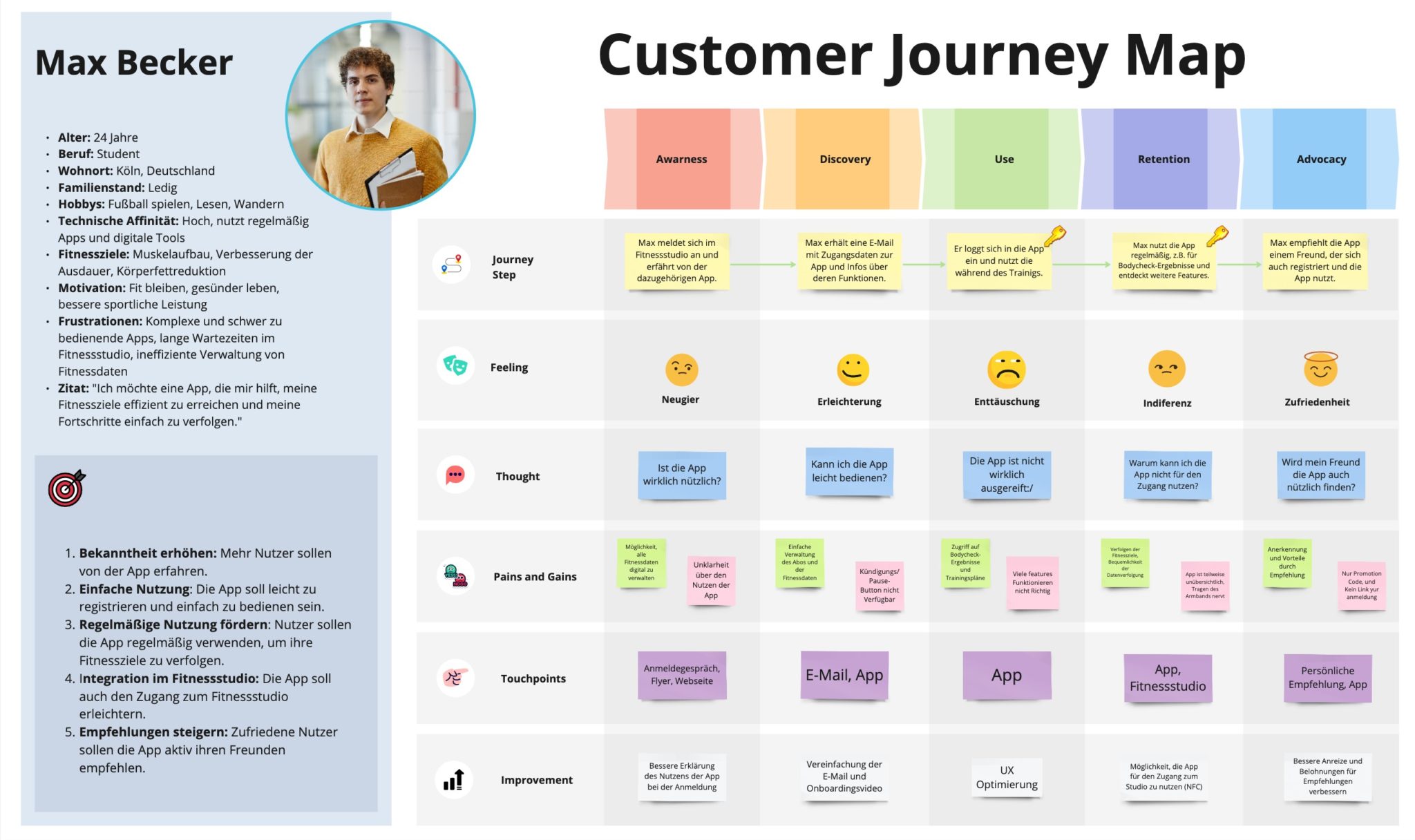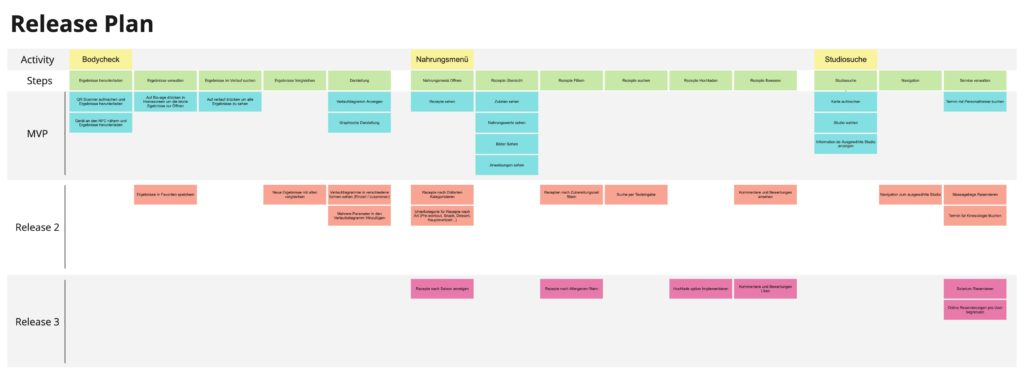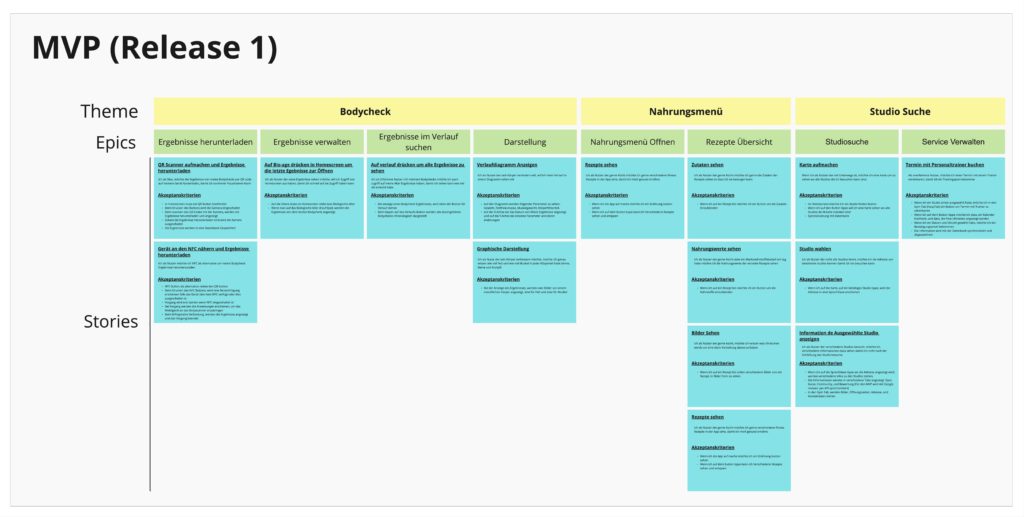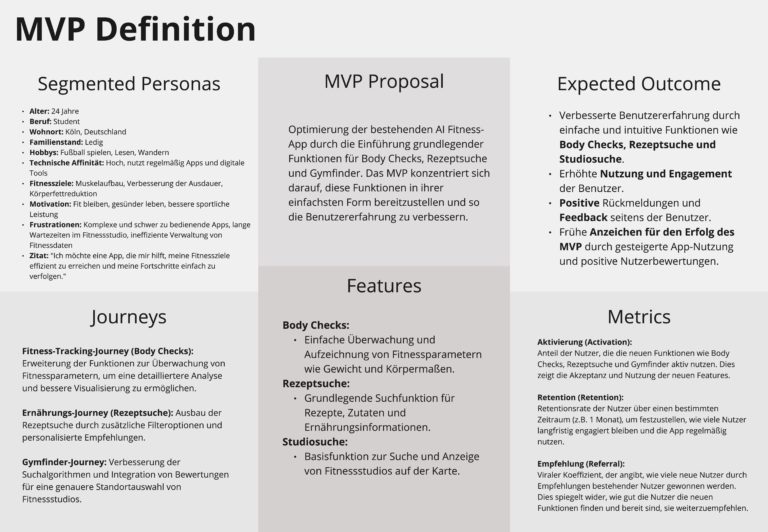Improving AI Fitness App: Customer Journey Mapping, User Story Mapping, and MVP Planning
Project Context
This project is a fictional case study, developed as part of an iterative product management exercise, focused on optimizing the AI Fitness app, the official application of the All-Inclusive Fitness gym chain. The goal was to analyze usability challenges and implement a structured Minimum Viable Product (MVP) approach to improve the user experience.
By applying Customer Journey Mapping (CJM), User Story Mapping, and Agile Release Planning, the project aimed to refine the gym membership experience, improve fitness tracking functionalities, and enhance user engagement with gym services.
Objective
The project focused on identifying key pain points within the AI Fitness app and structuring an MVP-first approach to deliver high-impact improvements. The objectives were:
- Conducting a Customer Journey Analysis to understand user frustrations and opportunities.
- Structuring a User Story Map to prioritize critical enhancements.
- Defining an MVP that delivers essential features in a phased rollout.
- Establishing a release plan aligned with Agile development methodologies.
The goal was to create a scalable and user-centered roadmap that improves the overall digital experience for AI Fitness gym members.
Methodology
- Customer Journey Mapping (CJM) – Persona & Feature Analysis: To understand both user needs and feature-level friction points, two distinct Customer Journey Maps were created:
- User Persona Journey – A step-by-step breakdown of how a gym member interacts with the AI Fitness app, from onboarding to long-term engagement: Feature-Specific Journey – A detailed breakdown of feature usability pain points, identifying opportunities to improve Body Checks, Recipe Search, and Gym Finder functionalities.
Key insights from the User Persona CJM:
- Onboarding complexity: Users found it difficult to understand the app’s value.
- Feature discoverability issues: Users struggled to locate and use core functions.
- Low retention motivation: There were no clear incentives for continued engagement.
- Limited advocacy potential: Users were unlikely to recommend the app due to lack of personalization.
MVP User Story Mapping
Following the Customer Journey Mapping (CJM), a User Story Map was created to prioritize and structure the most critical product improvements. From the analysis, three key functionalities were identified as essential to improving the user experience:
Body Checks – A streamlined fitness tracking system, enabling users to monitor weight, body composition, and progress.
Recipe Search – A simplified nutrition planning tool allowing users to search for recipes, ingredients, and nutritional data.
Gym Finder – A location-based tool for discovering AI Fitness gym locations, viewing amenities, and reading user reviews.
These three features formed the basis for a structured release plan, divided into the following stages:
MVP (Release 1): Implementation of the core functionalities to address the most urgent user pain points.
Release 2: Feature enhancements and personalization options, building on the MVP.
Release 3: Expansion of advanced tools, booking capabilities, and community engagement features.
Each functionality was prioritized based on a combination of user needs, technical feasibility, and potential impact on engagement.
From Prioritization to Implementation: Themes, Epics, and User Stories
After defining the three core features for the MVP—Body Checks, Recipe Search, and Gym Finder—the next step was to break down the solution into a structured feature hierarchy consisting of Themes, Epics, and User Stories.
Each User Story was formulated to capture a concrete unit of user value and was linked to a broader Epic within one of the three prioritized Themes. For every User Story, Acceptance Criteria were defined to ensure clarity, testability, and alignment with user expectations. These criteria served as the foundation for both development and validation.
Example structure:
Theme: Health & Progress Monitoring
Epic: Body Check Tracking
User Story:
As a user, I want to record my current weight and body fat percentage so that I can track my physical progress over time.
Acceptance Criteria:
Input fields for weight and body fat percentage are available
Data is saved and retrievable across sessions
A visual chart reflects changes over time based on entered values
This methodical breakdown ensured that the MVP was lean but fully functional, delivering clear and validated user value from the first release onwards.
Effort Estimation and Sprint Planning
After defining the User Stories for the MVP, I estimated the development effort using Story Points based on the Fibonacci sequence. This allowed me to assess the relative complexity of each task in a structured and scalable way.
I assumed a velocity of 20 Story Points per sprint for a team of five developers and distributed the Stories across several sprints accordingly. The focus was on balancing effort while ensuring that each sprint delivered a coherent, testable product increment.
The estimation covered all major functionalities of the MVP: Body Checks, Recipe Search, and Gym Finder. For each area, I assigned Story Points to individual tasks—such as integrating QR and NFC scanning, displaying progress charts, filtering recipes, or implementing map-based gym search.
Based on these estimations, I developed an initial sprint plan consisting of three sprints. This plan served as the basis for a realistic and transparent roadmap, allowing me to validate that the MVP scope could be implemented within the assumed development capacity.
Definition of Done (DoD)
To ensure the delivery of high-quality and production-ready features, I developed a comprehensive Definition of Done (DoD) for the MVP. The DoD established clear criteria for when a User Story could be considered complete—technically, functionally, and from a user experience perspective.
The checklist covered all relevant dimensions of software quality, from code and testing to usability and deployment:
Code Review: Each story had to be reviewed by a second developer, with all comments resolved. The code needed to comply with agreed coding standards and guidelines.
Product Owner Approval: Stories were reviewed and formally accepted by the Product Owner. Any feedback provided was implemented before closure.
Automated Testing: Automated tests were written for core functionalities and had to pass successfully.
Bug Handling: No critical or high-priority bugs were allowed at the time of completion. Any issues found were resolved or documented and prioritized.
Documentation: Both user-facing and system-level documentation were updated and written clearly.
User Interface: The UI had to match the UX/UI design specifications and be reviewed by a designer.
Integration: Integration with existing systems and components had to be tested and completed successfully.
Performance: Features were tested against defined performance requirements. No major performance issues were permitted.
Security: All relevant security aspects were reviewed and had to comply with internal security guidelines.
Deployment: Each story was deployed to a staging environment and tested successfully. Deployment processes were documented and, where possible, automated.
This Definition of Done ensured a shared understanding of quality standards across the team, helping to maintain consistency and reliability throughout the development of the MVP.
Final MVP Definition
To align all planning efforts with a clear product goal, I developed a structured MVP definition. The aim was to improve the existing AI Fitness app by introducing three core functionalities—Body Checks, Recipe Search, and Gym Finder—in their most basic usable form.
The MVP proposal was centered around providing these features in a way that is simple, intuitive, and directly valuable to users, while minimizing development overhead. This ensured that the initial version of the app could be launched quickly, tested with users, and used to validate core assumptions.
The MVP focused on the following elements:
-
Segmented Personas: A defined user profile (e.g., 24-year-old student, tech-savvy, health-conscious) helped guide feature relevance and design priorities.
-
User Journeys: Specific flows were outlined for tracking fitness data, discovering recipes, and finding suitable fitness studios.
-
Features: Each of the three core features included only the most essential functionality needed to solve user problems and deliver value.
-
Expected Outcomes: Improvements in usability, engagement, and early indicators of product–market fit were defined as success criteria.
-
Success Metrics: KPIs such as activation rate, retention, and referral potential were selected to validate the MVP’s impact after release.
This MVP definition acted as the guiding reference point for design, development, testing, and validation—ensuring a consistent, value-driven approach from concept to execution.
Conclusion
This project demonstrated how a structured and user-centered approach can transform product development within the fitness industry. By combining Customer Journey Mapping, User Story Mapping, effort estimation, and a clearly defined Minimum Viable Product, I was able to create a comprehensive release plan that balances user needs, technical feasibility, and delivery focus.
The work included everything from persona definition and feature breakdowns to acceptance criteria, story point estimations, and quality standards (Definition of Done)—ensuring that every step of the product process was intentional and value-driven.
Although this was a fictional case, it reflects real-world challenges and solutions in product management and serves as a model for how digital fitness solutions can be strategically designed and delivered.
The result is a scalable and focused product vision for the AI Fitness app that sets the foundation for continuous improvement and long-term user engagement.





